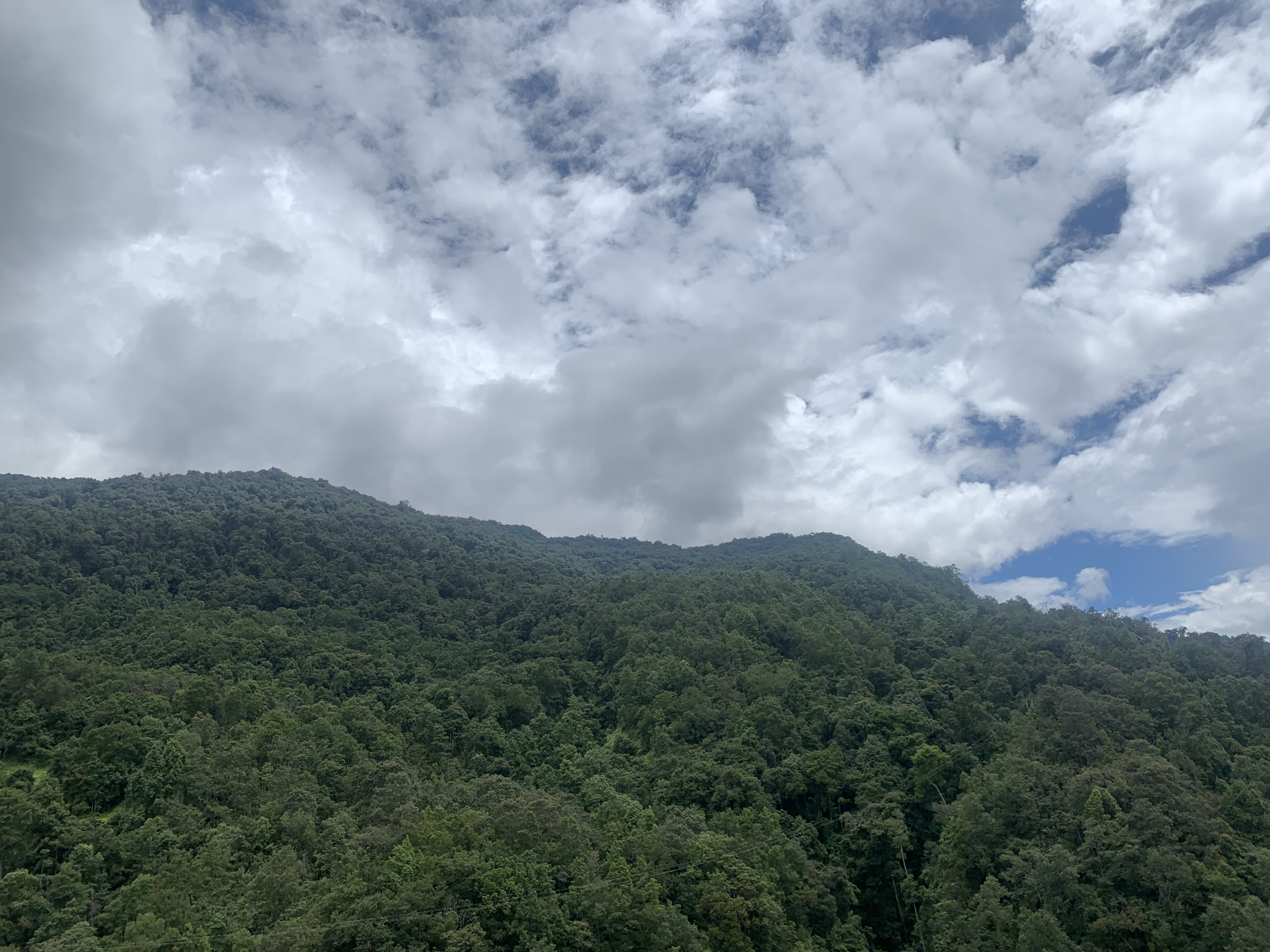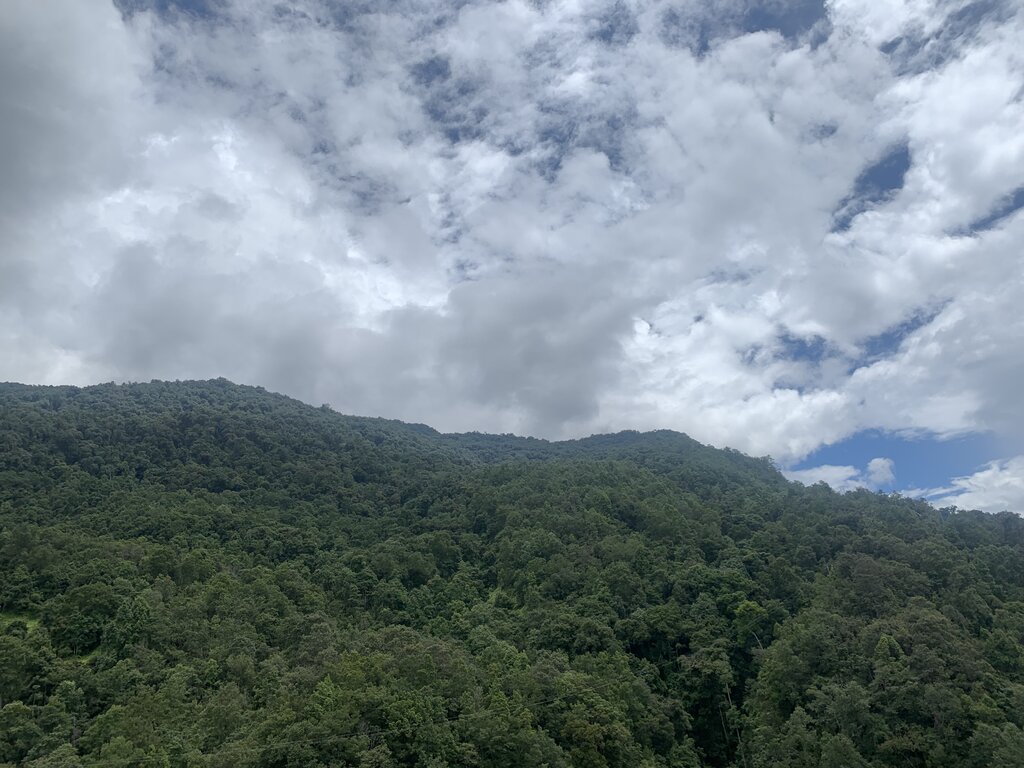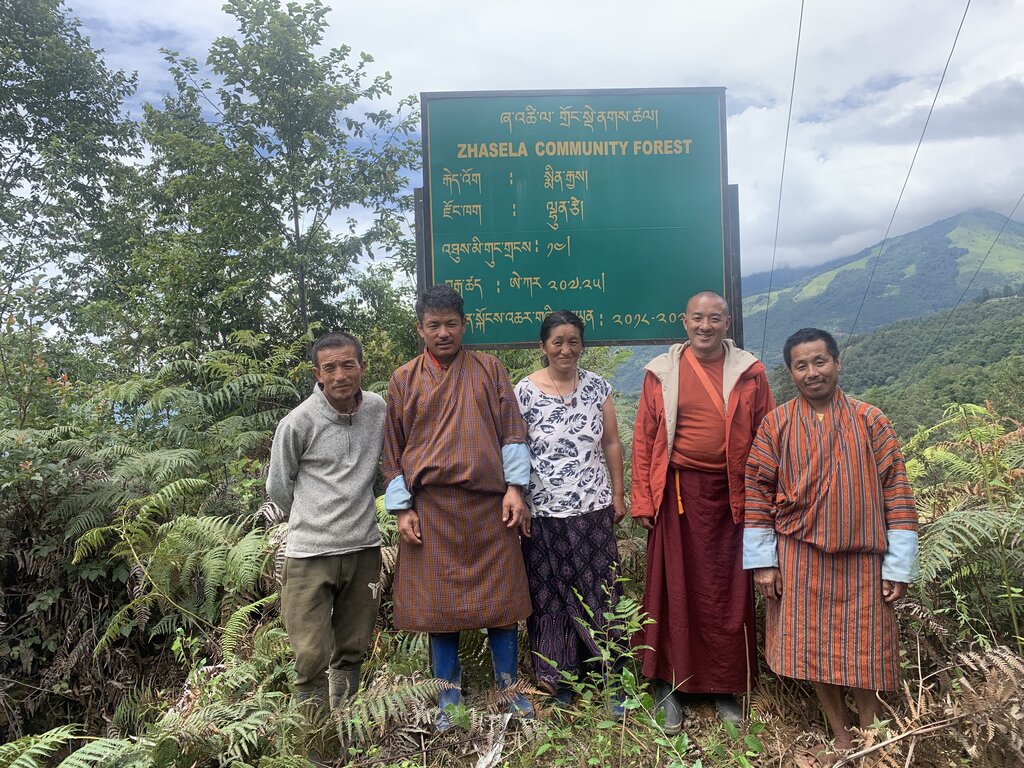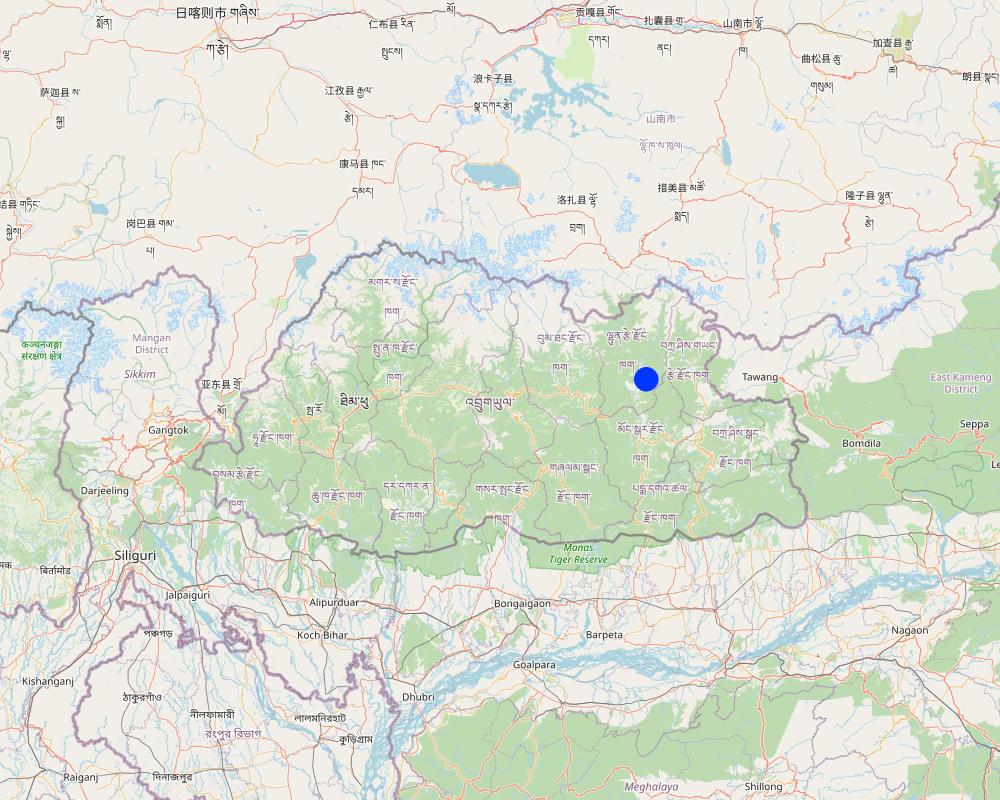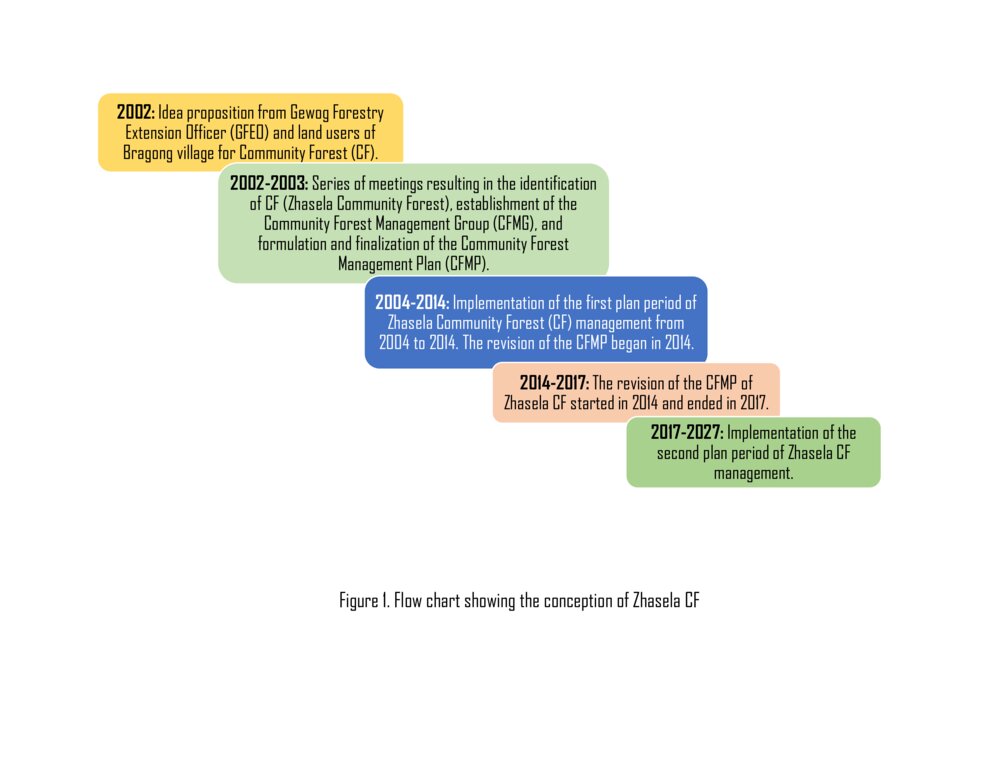Zhasela Community Forest Management Group (CFMG) [Bhutan]
- Creation:
- Update:
- Compiler: Tshering Yangzom
- Editor: Tashi Wangdi
- Reviewers: William Critchley, Rima Mekdaschi Studer
approaches_6892 - Bhutan
View sections
Expand all Collapse all1. General information
1.2 Contact details of resource persons and institutions involved in the assessment and documentation of the Approach
Key resource person(s)
land user:
Dorji Palden
17945217
Bragong village, Jalang chiwog, Minjey gewog, Lhuentse Dzongkhag
Bhutan
land user:
Rinzin Tshewang
17740115
Bragong village, Jalang chiwog, Minjey gewog, Lhuentse Dzongkhag
Bhutan
land user:
Yangchenmo
77737061
Bragong village, Jalang chiwog, Minjey gewog, Lhuentse Dzongkhag
Bhutan
land user:
Norbu Sonam
17903318
Bragong village, Jalang chiwog, Minjey gewog, Lhuentse Dzongkhag
Bhutan
land user:
Yonten Kinga
17739175
Bragong village, Jalang chiwog, Minjey gewog, Lhuentse Dzongkhag
Bhutan
Name of project which facilitated the documentation/ evaluation of the Approach (if relevant)
Strengthening national-level institutional and professional capacities of country Parties towards enhanced UNCCD monitoring and reporting – GEF 7 EA Umbrella II (GEF 7 UNCCD Enabling Activities_Umbrella II)Name of the institution(s) which facilitated the documentation/ evaluation of the Approach (if relevant)
National Soil Services Center, Department of Agric (National Soil Services Center, Department of Agric) - Bhutan1.3 Conditions regarding the use of data documented through WOCAT
When were the data compiled (in the field)?
23/07/2023
The compiler and key resource person(s) accept the conditions regarding the use of data documented through WOCAT:
Yes
2. Description of the SLM Approach
2.1 Short description of the Approach
The Zhasela Community Forest (CF) in Lhuentse covers an area of approximately 208 acres (83 ha). The Zhasela CF Management Group (CFMG), consisting of members of 15 households, has been formed for sustainable utilization and management of forest resources, protection of water sources, and income generation through the sale of sustainable forest products to reduce poverty.
2.2 Detailed description of the Approach
Detailed description of the Approach:
Zhasela Community Forest (CF) covers an area of approximately 208 acres (83 ha). The community forest name “Zhasela” is derived from the local deity of the forest, Zhasela. The CF is a cool broadleaf forest. The dominant tree species found are the species of the genera Michelia, Persia, Symplocos, Betula, and Cinnamomum. The CF is looked after by the Community Forest Management Group (CFMG) consisting of members of 15 households. The operation of the CFMG is guided by the Community Forest Management Plan (CFMP). The first period of Zhasela CF management was between 2004 and 2014. The CF coverage was around 84 acres (33 ha) with 13 CFMG households. At the end of the first planning period, the CF management was retained and the CFMP revised for the next 10 years. The revised plan period was completed in 2017 with the addition of almost 124 acres (50 ha) resulting in a total 208 acres (83 ha). The CFMG members increased from 13 to 15 households. The CFMG carries out the activities highlighted in the CFMP.
The main objectives of the approach are sustainable utilization and management of forest resources, protection of water sources, and income generation through the sale of sustainable forest products to reduce poverty.
Apart from the CFMG members, the stakeholders involved in the approach are the territorial division office, Gewog Forestry Extension Officer (GFEO), and CFMG members. The territorial division office's roles include training CFMG on a need's basis; providing technical inputs while implementing the CFMP; monitoring and providing feedback on CFMP implementation; providing market information and supporting marketing; providing support for amendment and revision of CFMP; verifying CFMG’s records annually; translating CFMP to a Dzongkha version; coordinating study tours; and disseminating or advertising information related to CF or CFMG.
What the CFMG members like about this approach is that it protects water sources, provides access to forest resources such as timber, fuel wood, and non-timber forest products (NTFPs) such as fodder, fencing/flag poles, and leaf litter. The approach also helps to resolve conflicts regarding access to forest resources, conserves the local forest, reduces erosion and landslides, and thus aids in habitat protection and biodiversity conservation.
In terms of the community, the approach also helps provide loans to members from the CF fund lending scheme with minimal interest. The other advantages of this approach include diversifying income sources by reducing dependency on a single source of income like livestock farming or crop production, strengthening social cohesion by empowering local communities to manage their resources collectively, facilitating collaboration among different stakeholders, sustainably utilizing and managing forest resources, and improving living standards and reducing poverty in rural communities.
2.3 Photos of the Approach
2.4 Videos of the Approach
Comments, short description:
Zhasela CF (a) https://youtu.be/frmoSnC_lJM
Zhasela CF (b) https://youtu.be/qeowNShMyeQ
Date:
23/07/2023
Location:
Bragong village, Jalang chiwog, Minjey gewog, Lhuentse Dzongkhag
Name of videographer:
Tshering Yangzom
2.5 Country/ region/ locations where the Approach has been applied
Country:
Bhutan
Region/ State/ Province:
Bragong village, Jalang chiwog, Minjey gewog, Lhuentse Dzongkhag
Map
×2.6 Dates of initiation and termination of the Approach
Indicate year of initiation:
2004
Comments:
The first plan period of Zhasela CF management was completed between 2004 and 2014. The revision of the first plan period was finished in 2017 with the addition of 123.55 acres to the CF.
2.7 Type of Approach
- recent local initiative/ innovative
2.8 Main aims/ objectives of the Approach
The main objectives of the approach are sustainable utilization and management of forest resources, protection of water sources, and income generation through the sale of excess forest products to reduce poverty.
2.9 Conditions enabling or hindering implementation of the Technology/ Technologies applied under the Approach
availability/ access to financial resources and services
- enabling
The CFMG has a ‘CF fund lending scheme’ where the money generated from selling CF resources such as surplus timber and wood products is lent to CFMG members at a minimal interest. Sometimes interest-free loans are provided to bereaved families and families bearing medical expenses due to sickness. The scheme provides relatively easy and cheap local access to cash for group members. During the first plan period of Zhasela CF management, CFMG generated more than Nu 320,000 from the sale of surplus timber and finished products. Nu 299, 600 was divided among the group members and each member received Nu 23,000.
institutional setting
- enabling
The CFMG has helped the members improve their livelihoods and reduce poverty. The CFMG generate income through the sale of forest resources to contractors, government agencies, and private individuals.
collaboration/ coordination of actors
- enabling
There is labour-sharing in the group for activities such as the plantation of seedlings, fire line creations, and overall forest management thereby easing workload in the group and improving collaboration and coordination. The CFMG members also help each other out in times of need. For example, Mr. Tshering Dorji's house was damaged by an earthquake in September 2009. In spring 2010, the CFMG allotted four drashing (trees of at least 50 cm diameter at breast height) from the CF free of cost to him for the reconstruction of his house.
knowledge about SLM, access to technical support
- enabling
Members realize the importance of the CF. They realize that the forest helps protect water sources, avoid erosions and land slides through land coverage, and increase wood production.
markets (to purchase inputs, sell products) and prices
- enabling
There is a good market for the sale of surplus timber from the CF. Timber is sold in the form of logs, planks, and finished products like altar. The CFMG has been able to earn a substantial amount from the sale of timber to contractors, government agencies, and private individuals.
workload, availability of manpower
- enabling
There is labour-sharing in the group thereby easing workload in the group.
3. Participation and roles of stakeholders involved
3.1 Stakeholders involved in the Approach and their roles
- local land users/ local communities
15 CFMG members from 15 households.
The CFMG members carry out the activities highlighted in the CFMP.
- SLM specialists/ agricultural advisers
GFEO
The GFEO monitors the activities implemented by the CFMG and provides necessary assistance in any field that the CF members require.
- national government (planners, decision-makers)
Territorial division office
The territorial division office's roles include training CFMG on a need base, providing technical inputs while implementing the Community Forest Management Plan (CFMP), monitoring and providing feedback on CFMP implementation, providing market information and supporting marketing, providing support for amendment and revision of CFMP, verifying CFMG’s records annually, translating CFMP to Dzongkha version, coordinating study tours, and disseminating or advertising information related to CF or CFMG.
3.2 Involvement of local land users/ local communities in the different phases of the Approach
| Involvement of local land users/ local communities | Specify who was involved and describe activities | |
|---|---|---|
| initiation/ motivation | interactive | The people of Bragong village had observed a gradual depletion of forest resources near their village. Forest resources such as timber, firewood, fencing/flag poles, fodder, and other forest products had become scarce. So, the community came forward with the proposal to establish a CF. Furthermore, the GFEO had been emphasizing CF's importance to the villagers multiple times. This eventually led to the formation of the CF. |
| planning | interactive | Forest territorial division office, GFEO, and CFMG members were involved. Through multiple discussions, they came up with the CFMP. |
| implementation | interactive | The territorial division office, GFEO, and CFMG were involved. They formulated and finalized the CFMP. The CFMG members then carried out the activities highlighted in the CFMP under the guidance of GFEO and territorial division office. |
| monitoring/ evaluation | interactive | The GFEO and CFMG members are involved. The monitoring of CF activities is done by all CF members. The necessary records are maintained by the nominated executive committee members (chairperson, secretary, treasurer) of CFMG. The executive members are mandated to submit annual progress reports to the GFEO. The GFEO monitor the activities implemented by CFMG. |
3.3 Flow chart (if available)
3.4 Decision-making on the selection of SLM Technology/ Technologies
Were decisions on the selection of the Technology(ies) made:
- Land users (CFMG members) and GFEO
Explain:
The people of Bragong village had observed a gradual depletion of forest resources near their village. Forest resources such as timber, firewood, fencing/flag poles, fodder, and other forest products had become scarce. So, the community came forward with the proposal to establish a CF. Furthermore, the GFEO had been emphasizing CF's importance to the villagers multiple times. This eventually led to the formation of the CF.
Specify on what basis decisions were made:
- personal experience and opinions (undocumented)
- The people of Bragong village had observed a gradual depletion of forest resources near their village. Forest resources such as timber, firewood, fencing/flag poles, fodder, and other forest products had become scarce. So, the community came forward with the proposal to establish a CF. Furthermore, the GFEO had been emphasizing CF's importance to the villagers multiple times. This eventually led to the formation of the CF.
4. Technical support, capacity building, and knowledge management
4.1 Capacity building/ training
Was training provided to land users/ other stakeholders?
Yes
Specify who was trained:
- land users
If relevant, specify gender, age, status, ethnicity, etc.
Both men and women.
Form of training:
- farmer-to-farmer
- demonstration areas
- courses
Subjects covered:
Accounting and record keeping
Forest management
Nursey management
Leadership skills
Power chain operation
4.2 Advisory service
Do land users have access to an advisory service?
Yes
Specify whether advisory service is provided:
- on land users' fields
- at permanent centres
Describe/ comments:
Land users have access to advisory services from the GFEO. The GFEO provides necessary assistance in any field that the CF members require and also advises the CFMG on the implementation of CFMP, the latest policies and amendments of the rule.
4.3 Institution strengthening (organizational development)
Have institutions been established or strengthened through the Approach?
- yes, greatly
Specify the level(s) at which institutions have been strengthened or established:
- local
Describe institution, roles and responsibilities, members, etc.
Land users have benefitted a lot from the CF, the water sources are protected, erosions and landslides are prevented, and there is sustainable utilization and management of forest resources. Also, land users are able to generate income through the sale of surplus forest products especially timber. During the first plan period of Zhasela CF management, CFMG generated more than Nu 320,000 from the sale of surplus timber and finished products. Nu 299, 600 was divided among the group members and each member received Nu 23,000.
Specify type of support:
- financial
- capacity building/ training
4.4 Monitoring and evaluation
Is monitoring and evaluation part of the Approach?
Yes
Comments:
The Chief Forestry Officer, Gewog Ranger, and land users are involved in monitoring and evaluation. The monitoring of CF activities is done by all CF members (land users). The necessary records are maintained by the nominated executive committee members (chairperson, secretary, treasurer) of CFMG. The executive members are mandated to submit annual progress reports to Gewog Ranger. The Chief Forestry Officer and Gewog Ranger monitor the activities implemented by CFMG.
If yes, is this documentation intended to be used for monitoring and evaluation?
No
4.5 Research
Was research part of the Approach?
No
5. Financing and external material support
5.1 Annual budget for the SLM component of the Approach
If precise annual budget is not known, indicate range:
- < 2,000
Comments (e.g. main sources of funding/ major donors):
There is no set annual budget for the SLM component of the approach but wherever necessary the land users use the CFMG fund and sometimes get financial and material support from the government.
5.2 Financial/ material support provided to land users
Did land users receive financial/ material support for implementing the Technology/ Technologies?
Yes
If yes, specify type(s) of support, conditions, and provider(s):
The CFMG received Nu.100,000 to carry out some of the activities reflected in the CFMP, four rolls of barbed wire, and some tree seedlings.
5.3 Subsidies for specific inputs (including labour)
- other
| Other (specify) | To which extent | Specify subsidies |
|---|---|---|
| The CFMG received Nu.100,000 from the government to carry out some of the activities reflected in the CFMP, four rolls of barbed wire, and some tree seedlings. | fully financed |
If labour by land users was a substantial input, was it:
- voluntary
5.4 Credit
Was credit provided under the Approach for SLM activities?
No
5.5 Other incentives or instruments
Were other incentives or instruments used to promote implementation of SLM Technologies?
No
6. Impact analysis and concluding statements
6.1 Impacts of the Approach
Did the Approach empower local land users, improve stakeholder participation?
- No
- Yes, little
- Yes, moderately
- Yes, greatly
CF management has improved participation among the member households. The CFMG members work together and carry out the activities highlighted in the CFMP. There is labour-sharing in the group for activities such as the plantation of seedlings, fire line creations, and overall forest management thereby easing workload in the group and improving collaboration and coordination. The CF has helped empower local communities to manage their resources collectively. The CFMG members also help each other out in times of need. For example, Mr. Tshering Dorji's house was damaged by an earthquake in September 2009. In spring 2010, the CFMG allotted four drashing (trees of at least 50 cm diameter at breast height) from the CF free of cost to him for the reconstruction of his house. CFMG has improved stakeholder participation between members and the government. Both land users and government officials like GFEO have benefitted through the CF. As for the members, due to CF, they have access to forest resources such as timber, fuel wood, fencing/flag poles, NWFPs, and free grazing. Their water sources are also protected and risks of erosions and landslides have been minimized. All of these motivate them to manage the forest. As for the GFEO, the forest is sustainably being managed by the members guided by CFMP thereby making their work easier. The members and the GFEO are working together with the officials giving technical advice and conducting periodic monitoring and the members carrying out various sustainable forest management field work. The CF has facilitated collaboration between different stakeholders.
Did the Approach enable evidence-based decision-making?
- No
- Yes, little
- Yes, moderately
- Yes, greatly
During the first plan period of Zhasela CF management, CFMG utilized 147 drashing (trees of at least 50 cm dbh which is used for sawn timber), 20 numbers of cham (trees of 30-50 cm dbh which are used for beams), 3 numbers of tsim (trees of 20-30 cm dbh which are used for large poles), and 4 numbers of dangchung (trees of 10-20 cm dbh which are used for small poles). The group also generated income through the sale of surplus timber and finished products (altars). The group generated more than Nu 320,000 from the sale of surplus timber and finished products. Nu 299, 600 was divided among the group members and each member received Nu 23,000. Some of the activities carried out in the first plan period were 2 acres of barren land were planted and maintained, a tree nursery was established, and approximately 5 acres of unwanted bushes were cleared for enhancement of regeneration and growth of retained trees. The water sources were protected and risks of erosions and landslides were minimized. The members got access to many forest resources. The members reaped a lot of benefits from the CF and this made them revise and continue CFMP for another 10 years (2017-2027). All the positive aspects of the CF enable evidence-based decision-making.
Did the Approach help land users to implement and maintain SLM Technologies?
- No
- Yes, little
- Yes, moderately
- Yes, greatly
The management of CF by the CFMG has helped land users protect water sources, minimize erosion and landslides, and sustainably use forest resources.
Did the Approach improve knowledge and capacities of land users to implement SLM?
- No
- Yes, little
- Yes, moderately
- Yes, greatly
CF has helped land users protect water sources and sustainably use forest resources.
CF management has improved participation among the member households. The CFMG members work together and carry out the activities highlighted in the CFMP. There is labour-sharing in the group for activities such as the plantation of seedlings, fire line creations, and overall forest management thereby easing workload in the group and improving collaboration and coordination. The CF has helped empower local communities to manage their resources collectively. The CFMG members also help each other out in times of need. For example, Mr. Tshering Dorji's house was damaged by an earthquake in September 2009. In spring 2010, the CFMG allotted four drashing (trees of at least 50 cm diameter at breast height) from the CF free of cost to him for the reconstruction of his house. CFMG has improved stakeholder participation between members and the government. Both land users and government officials like GFEO have benefitted through the CF. As for the members, due to CF, they have access to forest resources such as timber, fuel wood, fencing/flag poles, NWFPs, and free grazing. Their water sources are also protected and risks of erosions and landslides have been minimized. All of these motivate them to manage the forest. As for the GFEO, the forest is sustainably being managed by the members guided by CFMP thereby making their work easier. The members and the GFEO are working together with the officials giving technical advice and conducting periodic monitoring and the members carrying out various sustainable forest management field work. The CF has facilitated collaboration between different stakeholders.
CF has resolved conflicts regarding access to forest resources.
Did the Approach empower socially and economically disadvantaged groups?
- No
- Yes, little
- Yes, moderately
- Yes, greatly
The CF has helped land users have access to forest resources such as timber, fuel wood, fencing/flag poles, and NWFPs and provided an opportunity to generate income.
Did the Approach improve gender equality and empower women and girls?
- No
- Yes, little
- Yes, moderately
- Yes, greatly
CFMG comprises both male and female land users. There is no gender discrimination.
Did the Approach improve issues of land tenure/ user rights that hindered implementation of SLM Technologies?
- No
- Yes, little
- Yes, moderately
- Yes, greatly
CF has resolved conflicts regarding access to forest resources.
Did the Approach lead to improved food security/ improved nutrition?
- No
- Yes, little
- Yes, moderately
- Yes, greatly
The CF has helped land users have access to forest resources such as timber, fuel wood, fencing/flag poles, and NWFPs and provided an opportunity to generate income. Also, CFMG provides loans to its members.
Did the Approach lead to improved access to water and sanitation?
- No
- Yes, little
- Yes, moderately
- Yes, greatly
The CF has helped protect the water sources.
Did the Approach lead to employment, income opportunities?
- No
- Yes, little
- Yes, moderately
- Yes, greatly
The land users generate income by selling forest products as they have access to forest resources.
6.2 Main motivation of land users to implement SLM
- reduced land degradation
Two acres of barren land were planted and maintained, a tree nursery was established, and approximately 5 acres of unwanted bushes were cleared for enhancement of regeneration and growth of retained trees.
- environmental consciousness
CF aids in protecting habitats and conserving biodiversity. Extensive exploitation of forest resources would result in soil erosion, landslides, deforestation, disruption of water cycles, and loss of ecosystem services.
- conflict mitigation
Resolve conflicts regarding access to forest resources.
6.3 Sustainability of Approach activities
Can the land users sustain what has been implemented through the Approach (without external support)?
- yes
If yes, describe how:
Sustainable use of resources in CF ensures regeneration and replenishment of harvested resources.
6.4 Strengths/ advantages of the Approach
| Strengths/ advantages/ opportunities in the land user’s view |
|---|
| Protection of water sources. |
| Access to forest resources such as timber, fuel wood, fencing/flag poles, fodder, leaf litter, and NWFPs. |
| Conflict mitigation due to clarity on access to forest resources. |
| Access to loans from the CF fund lending scheme with minimal interest. |
| Conservation of local forest. |
| Reduce erosion and landslides in the area. |
| Habitat protection and biodiversity conservation. |
| Strengths/ advantages/ opportunities in the compiler’s or other key resource person’s view |
|---|
| Diversify income sources by reducing dependency on a single source of income like livestock farming or crop production. |
| Improve living standards and reduce poverty in rural communities. |
| Sustainable utilization and management of forest resources. |
| Strengthen social cohesion by empowering local communities to manage their resources collectively. |
| Facilitate collaboration among different stakeholders. |
6.5 Weaknesses/ disadvantages of the Approach and ways of overcoming them
| Weaknesses/ disadvantages/ risks in the compiler’s or other key resource person’s view | How can they be overcome? |
|---|---|
| Farmers are not able to sell NWFPs due to a lack of markets in the vicinity. | Since one of the roles and responsibilities of the territorial division office is to provide market information and support marketing (as highlighted in CFMP), it should come up with ways to link land users and markets in Lhuentse. |
7. References and links
7.1 Methods/ sources of information
- field visits, field surveys
Five land users
- interviews with land users
Five land users
- compilation from reports and other existing documentation
Referred Zhasela CFMP booklet.
7.2 References to available publications
Title, author, year, ISBN:
Phuntsho, S., Schmidt, K., Kuyakanon, R., & Temphel, K. J. (n.d.). Community Forestry in Bhutan: Putting People at the Heart of Poverty Reduction.
Available from where? Costs?
http://uwice.gov.bt/admin_uwice/publications/publication_files/Reports/2011/UWICER-CFIB.pdf#page=27
Title, author, year, ISBN:
Wangchuk, S. (2014). Equity in Community Forestry Management: A Case of Lhuentse and Mongar Dzongkhags, Eastern Bhutan. Journal of the Bhutan Ecological Society, 48–59.
Available from where? Costs?
https://www.researchgate.net/profile/Sonam-Wangchuk-5/publication/313663481_Equity_in_Community_Forestry_Management_A_Case_of_Lhuentse_and_Mongar_Dzongkhags_Eastern_Bhutan/links/58a2047f45851598babae778/Equity-in-Community-Forestry-Management-A-Case-of-Lhuentse-and-Mongar-Dzongkhags-Eastern-Bhutan.pdf
7.3 Links to relevant information which is available online
Title/ description:
Phuntsho, S., Schmidt, K., Kuyakanon, R., & Temphel, K. J. (n.d.). Community Forestry in Bhutan: Putting People at the Heart of Poverty Reduction.
URL:
http://uwice.gov.bt/admin_uwice/publications/publication_files/Reports/2011/UWICER-CFIB.pdf#page=27
Links and modules
Expand all Collapse allLinks
No links
Modules
No modules


